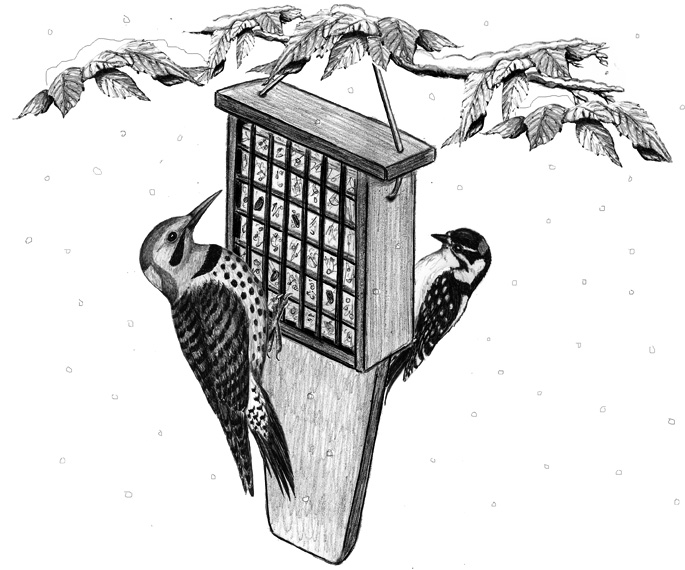
Dear Bird Folks,
As per your suggestions, I have put out a feeder filled with sunflower seeds and also have a heated birdbath. I’m getting quite a few birds, but is there something else I should also put out? I’d like to get even more birds.
– Ed, Harwich, MA
Yes, there is, Ed,
You are missing one key food item that would likely attract a whole new batch of birds to your yard. (Birds come in “batches,” right?) I applaud your use of sunflower seed. Water is good, too, especially this time of year when it can be a magnet for robins and bluebirds. Both birds ingest lots of berries during the winter and more often than not, the berries are fermented and now laced with alcohol. In order to process the alcohol out of their systems, the birds must drink large quantities of water. Being intoxicated is not a big deal for the robins; they like that look. But it can totally ruin the bluebirds’ saintly image. I mean, nobody wants to see a family of bluebirds pulled over for FUI (the birds’ version of DUI).
The important food that you aren’t giving your birds is suet. Good old beef suet, the stuff butchers used to give away, has become a popular item for feeding birds. Is suet better than the sunflower seed? No, suet is not better. It just appeals to different birds, namely woodpeckers. And woodpeckers are wonderful birds to have around (unless you happen to be a tree).
Woodpeckers have a varied diet, but insects and insect larvae are at the top of their list of favorite foods. However, filling your feeder with larvae isn’t for everyone. So, most folks use suet instead. Raw suet, the kind typically sold at the meat market, is inexpensive and the birds love it. There is a downside to raw suet, however. Just as is the case with meat, raw suet spoils very quickly. Therefore, it can only be used in cold weather. If you use raw suet when it’s warm, it will turn rancid and instead of getting woodpeckers, you’ll probably end up with batches of vultures.
Most people find it easier to use commercially made suet cakes, which don’t spoil in warm weather. Typically, these cakes are a 5”X5” square, or about the size of a thick waffle, only without the yummy butter and syrup. Commercial suet is rendered (boiled down) and mixed with corn meal and other grains, which helps bind it all together. Suet cakes are not as cheap as meat market suet, but they are reasonable. They often sell for less than a buck, but the prices can fluctuate depending upon the ingredients (and the retailer). Speaking of ingredients, suet manufacturers produce an enormous variety of these cakes, and each cake includes specialized ingredients. However, these ingredients aren’t necessarily added to attract more birds. They are actually added to entice more consumers. Cherry, orange, pecans and cranberries are found in many of the high-end suet cakes. Whilst these cakes might sound delicious to us, the birds really don’t care. Think about it. Have you ever seen a bird eat a cranberry? (The answer is no, and you never will.) On average, we sell 400 suet cakes per week and most of these cakes are the cheap ones. In other words, don’t waste your money on expensive suet. Wait! Did I just suggest people should spend less money? I must be coming down with something. That also explains why I’m suddenly using odd words like, “whilst” in my answers. Where did that come from?
Next we’ll talk about the feeder itself. A suet feeder is basically nothing more than a small wire cage. As is the case with the cakes, you shouldn’t spend a lot of money on a suet cage. After all, the birds don’t mind what it looks like, plus sooner or later the raccoons are going to end up stealing it. (You’ll see.) However, there is one option you may want to consider and that’s getting a feeder with a “tail prop.” What is a tail prop? A tail prop is a piece of wood that hangs about six inches below the cage. Why is that important? When a woodpecker is digging into a tree it uses its tail like a kickstand to brace itself against the trunk. Adding the tail prop allows the bird to feed more naturally. Of course, the birds will use a feeder without a tail prop; but they seem to prefer the feeders that have them. Raccoons, on the other hand aren’t that fussy. They’ll happily steal your suet feeder, with or without a tail prop. (You’ll see.)
Right now you might be wondering if offering suet is worth it. Yes, I think it is. (Besides, you are the one who started the whole, “I want more birds” thing.) What new birds come for suet? Here on Cape Cod there are four species of woodpeckers that regularly come to feeders. We have the totally sweet Downy Woodpecker (well, it’s sweet if it isn’t drilling holes into your house). Next is the downy’s larger “twin” cousin, the Hairy Woodpecker. In recent years we have also been seeing more Red-bellied Woodpeckers, which is a bird that ironically has a lot of red on its head, but not so much on its belly. Lastly, is the Cape’s largest woodpecker, the Northern Flicker. In addition to woodpeckers, suet also attracts warblers, wrens, creepers and even bluebirds, except to my yard. Bluebirds hate me.
I would definitely put out suet, Ed. But instead of buying just one feeder, I suggest you buy two. That way you’ll have one to put out for your birds, whilst you are looking for the one the raccoons stole the night before. (You’ll see.)